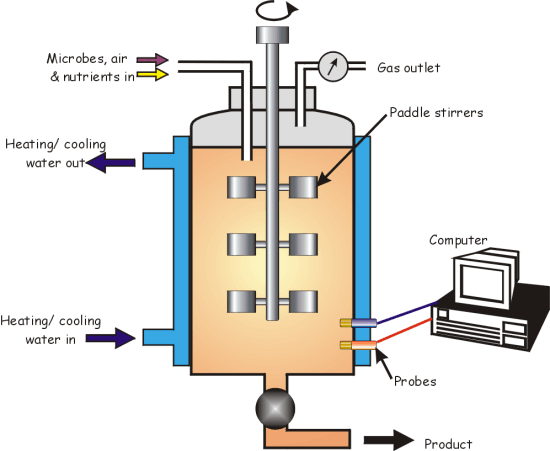Fermenters
Microbes can be used by industry to mass produce certain important chemicals. Some of these, like insulin are used in medicine to treat patients. Microbes are very efficient and produce less waste than chemical means. Often a product cannot be made any other way. Below is a diagram of a typical fermenter.

The vessel itself is made from stainless steel which does not corrode or affect the microbes and fermentation products. It can also be easily cleaned. Microbes and nutrients are put into the fermenter and air is bubbled through so that the microbes can respire aerobically. As carbon dioxide builds up the gas outlet releases it to avoid build up of pressure. A water jacket surrounding the fermenter maintains an optimum temperature so the proteins do not become denatured. Temperature, pH and oxygen probes are linked to a computer which monitors the conditions inside the vessel. Paddle stirrers ensure that the microbes, nutrients and oxygen are well mixed and distributes the heat evenly. The product is run off from the bottom. It is separated from the microbes and purified so that it can be sold or distributed.
There are a number of different chemicals which can be made using microbes in fermeters.
Vinegar is made by converting ethanol into ethanoic (ascetic) acid using microbes. Ethanol, microbes and oxygen are mixed in a fermenter. Wood shavings are added to increas the surface for the fermentation by the microbes.
Alcohol can be made from cane sugar waste and yeast. The resulting ethanol is often mixed with petrol to create Gasohol, a cheap fuel for cars.
A simplified version of the fermenter can be used to create natural gas for use as a fuel. Household or farm waste is put in the fermenter. Anaerobic bacteria produce methane as the waste is broken down.
Chemicals like insulin and penicillin are often made in large fermenters for use in medicine.
